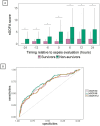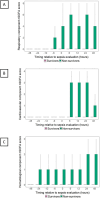Assessing neonatal Sequential Organ Failure (nSOFA) scores in suspected late-onset neonatal sepsis among preterm infants: implications for morbidity and mortality
- PMID: 39734076
- PMCID: PMC11683960
- DOI: 10.1136/bmjpo-2024-002884
Assessing neonatal Sequential Organ Failure (nSOFA) scores in suspected late-onset neonatal sepsis among preterm infants: implications for morbidity and mortality
Abstract
Background: The neonatal Sequential Organ Failure Assessment (nSOFA) score is an organ dysfunction score developed for predicting mortality risk in preterm neonates with proven late-onset neonatal sepsis (LONS) and necrotising enterocolitis. However, the utility of the nSOFA score in determining the risk of retinopathy of prematurity (ROP), bronchopulmonary dysplasia (BPD) or mortality in patients with suspected LONS is unknown.
Methods: We performed a dual-centre retrospective cohort study of preterm (gestational age <32 weeks) neonates suspected of LONS, from 2016 to 2020 at two neonatal intensive care units. The nSOFA scores (range 0-15) were calculated for each suspected LONS episode at various time points around the sepsis evaluation. A nSOFA burden score was calculated, by counting each time point the nSOFA score was ≥4 during all sepsis episodes (in the time period -6 to 48 hours). The association with 10-day sepsis-related mortality and severe ROP and BPD was assessed.
Results: A total of 1157 episodes of suspected LONS in 706 neonates occurred. The nSOFA was significantly associated with 10-day mortality at various time points. The nSOFA score 6 hours after drawing a blood culture (T6) was associated with 10-day sepsis-related mortality (adjusted OR (aOR) 1.31; 95% CI (1.22 to 1.40; p<0.001)), in a model corrected for gestational age, sex, age at evaluation and gestational age-adjusted birth weight. The nSOFA burden scores were positively associated with the risk for ROP (aOR 1.24; 95% CI 1.09 to 1.41; p=0.001) and BPD (aOR 1.30; 95% CI 1.13 to 1.50; p<0.001).
Conclusion: Our findings show that the nSOFA score in preterm neonates suspected of LONS is associated with subsequent mortality, ROP and BPD. Incorporating nSOFA scores may help to identify sepsis survivors at the highest risk of adverse outcomes, who may require more intensive monitoring and adapted therapy.
Keywords: Neonatology.
© Author(s) (or their employer(s)) 2024. Re-use permitted under CC BY-NC. No commercial re-use. See rights and permissions. Published by BMJ Group.
Conflict of interest statement
Competing interests: None declared.
Figures



Similar articles
-
Comparing nSOFA, CRIB-II, and SNAPPE-II for predicting mortality and short-term morbidities in preterm infants ≤32 weeks gestation.Ann Med. 2024 Dec;56(1):2426752. doi: 10.1080/07853890.2024.2426752. Epub 2024 Nov 9. Ann Med. 2024. PMID: 39520140 Free PMC article.
-
Neonatal Sequential Organ Failure Assessment Score Predicts Respiratory Outcomes in Preterm Newborns with Late-Onset Sepsis: A Retrospective Study.Neonatology. 2025;122(1):56-65. doi: 10.1159/000539526. Epub 2024 Nov 5. Neonatology. 2025. PMID: 39500295
-
Evaluation of the Neonatal Sequential Organ Failure Assessment and Mortality Risk in Preterm Infants With Late-Onset Infection.JAMA Netw Open. 2021 Feb 1;4(2):e2036518. doi: 10.1001/jamanetworkopen.2020.36518. JAMA Netw Open. 2021. PMID: 33538825 Free PMC article.
-
Inositol in preterm infants at risk for or having respiratory distress syndrome.Cochrane Database Syst Rev. 2019 Jul 8;7(7):CD000366. doi: 10.1002/14651858.CD000366.pub4. Cochrane Database Syst Rev. 2019. PMID: 31283839 Free PMC article.
-
Sequential organ failure assessment scores to predict outcomes: from adults to neonates.Curr Opin Pediatr. 2023 Apr 1;35(2):218-222. doi: 10.1097/MOP.0000000000001207. Epub 2022 Nov 29. Curr Opin Pediatr. 2023. PMID: 36449658 Review.
References
Publication types
MeSH terms
LinkOut - more resources
Full Text Sources
Medical
